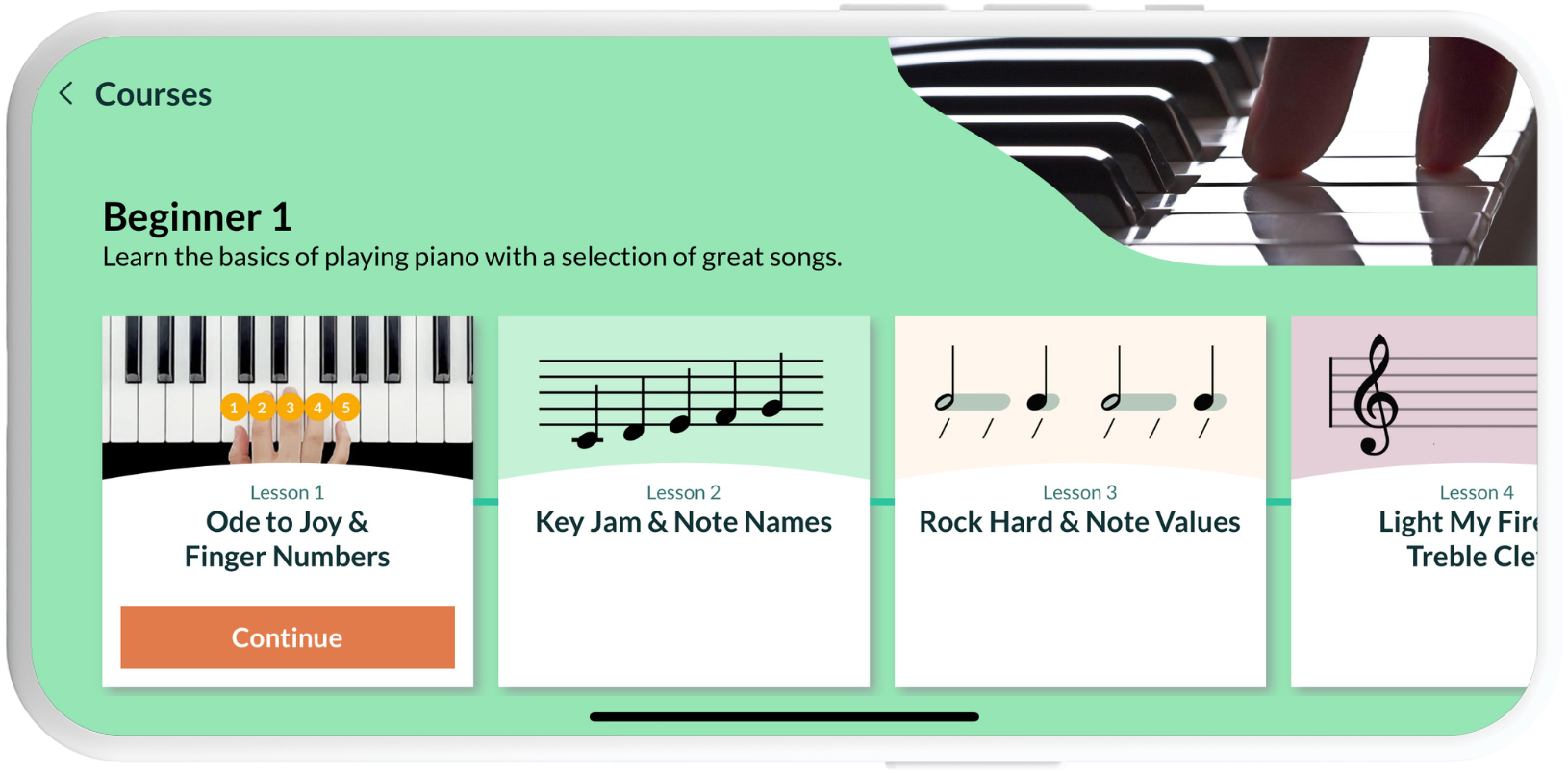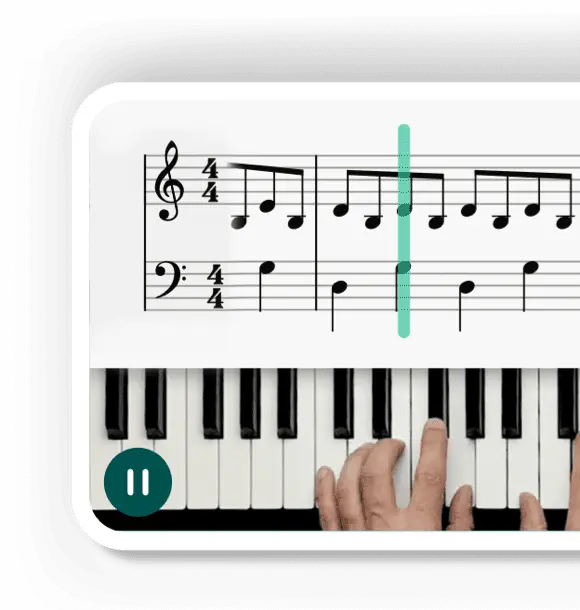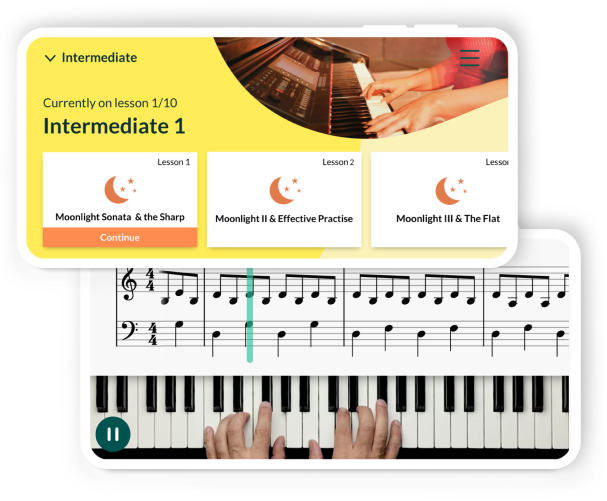In the vast world of music, chords are the pillars that uphold the beauty of every tune. They’re the foundation of songs, the essence of melodies, and the soul of harmonies. Mastering chords, especially ones as versatile as the F♯ chord is essential for anyone aspiring to play the piano with flair and finesse.
This guide is your compass to navigate the world of the F♯ major piano chord. Our mission is to demystify the F♯ piano chord for you, breaking it down, note by note, so you can play it with confidence and clarity. Whether you’re just starting your musical journey or looking to perfect your skills, this guide will be your trusted companion. We’ll delve deep into the nuances of the F♯ on piano, ensuring that by the end, the F♯ piano chord will be second nature to you.

No credit card details required
Defining the F♯ chord
Each chord brings a unique flavor to a composition. Among these, the F♯ major chord stands out for its rich resonance and versatility. Often found gracing the scores of both classical compositions and contemporary hits, the F♯ chord variations are a must-know for any budding pianist.
Visual representation of the F♯ chord
Imagine the piano keys in front of you. The F♯ on piano is that distinct black key nestled right after the F key. When playing the F♯ chord variation, you’ll be pressing this key along with a couple of others to produce that signature sound. For a visual representation:

Notes of the F♯ major chord
The F♯ major piano chord is made up of three primary notes:
- F♯ (Root)
- A♯ (Third)
- C♯ (Fifth)
These three notes, when played together, produce the harmonious sound of the F♯ piano chord that we’re familiar with.
Distinction between major and minor triads
At the heart of chords lies the concept of triads. A triad is a set of three notes played simultaneously. Major and minor triads are the most basic and essential forms of these. The primary difference between them lies in the third note, or the “third.” In major triads, the third is four half steps away from the root note, while in minor triads, it’s only three.
Differences in sound, feel, and musical notation
Major triads, like the F♯ major piano chord, have a happy, uplifting sound. They’re bright, clear, and resonate with positivity. Minor triads, on the other hand, have a more somber, melancholic feel. They’re deeper, moodier, and often evoke feelings of sadness or introspection.
In musical notation, the major chords are usually represented by just the root note (e.g., F♯ for F♯ major), while minor chords have an added “m” (e.g., F♯m for F♯ minor).
Playing the F♯ chord: step-by-step
Whether you’re a beginner or someone brushing up on their skills, mastering the F♯ chord variations are a rewarding experience. Let’s break down the process step-by-step, ensuring you get the finger positioning, hand placement, and techniques just right.
Locating the F♯ key on the piano
Before you start playing, you need to know where the F♯ on piano is. Look at the set of black keys on piano. The F♯ piano key is the first black key in each set of three black keys. It’s right after the white F key. Familiarize yourself with this key as it’s the root note of the F♯ major piano chord.
Finger placement for the F♯ major chord
To play the F♯ piano chord, you’ll be pressing three keys simultaneously: F♯, A♯, and C♯. Here’s how to position your fingers:
- Thumb (1st finger): Place it on the F♯ key.
- Middle finger (3rd finger): Position it on the A♯ key.
- Little finger (5th finger): This goes on the C♯ key.
For the left hand, the finger placement is slightly different:
- Little finger (5th finger): Place it on the F♯ key.
- Middle finger (3rd finger): Position it on the A♯ key.
- Thumb (1st finger): This goes on the C♯ key.
Hand positioning
Ensure your hand is relaxed and forms a natural curve over the keys. Your fingers should be slightly curved, allowing for easy movement across the keys. Your wrist should be level with the keyboard, neither too high nor too low.
Playing the chord
Press down on the F♯, A♯, and C♯ keys simultaneously. Ensure you apply even pressure with all fingers to produce a clear and harmonious sound. Practice pressing and releasing the keys to familiarize yourself with the feel and sound of the F♯ chord variation.
Exploring the inversions of the F♯ piano chord
Beyond the basic formation of a chord lies the fascinating world of chord inversions. These inversions offer a fresh perspective on familiar chords, adding depth and variety to your musical repertoire. Let’s dive deep into the inversions of the F♯ piano chord and discover the magic they hold.
Introducing chord inversions
Imagine you have a set of three colored blocks: red, blue, and green. While the default order might be red on top, followed by blue and then green, what happens if you change the order? The colors remain the same, but their arrangement offers a fresh visual experience. This is the essence of chord inversions in music.
A chord inversion is essentially a rearrangement of the notes within a chord. For the F♯ chord variation, instead of the standard F♯ – A♯ – C♯ formation (root position), you might play A♯ – C♯ – F♯ (first inversion) or C♯ – F♯ – A♯ (second inversion). The notes remain consistent, but their order changes, offering a new sonic texture.
1st inversion of the F♯ chord
Notes and finger placements
The 1st inversion of the F♯ piano chord rearranges the notes of the root position (F♯ – A♯ – C♯) to A♯ – C♯ – F♯. Here’s how to position your fingers:
Right hand
- Thumb (1st finger): Place it on the A♯ key.
- Index finger (2nd finger): Position it on the C♯ key.
- Ring finger (4th finger): This goes on the F♯ key.
Left hand
- Little finger (5th finger): Place it on the A♯ key.
- Middle finger (3rd finger): Position it on the C♯ key.
- Thumb (1st finger): This goes on the F♯ key.
Use in music and distinction from root position
The 1st inversion of the F♯ chord variation offers a brighter, more elevated sound compared to the root position. It’s often used to create a sense of upliftment or transition in a piece. Musically, it provides a smoother connection between chords, especially when moving from lower to higher chord progressions. The change in note arrangement gives it a slightly more open and airy feel, making it a favorite for creating musical bridges or transitions.
2nd inversion of the F♯ chord
Notes and finger placements
For the 2nd inversion of the F♯ chord variation, the notes shift to C♯ – F♯ – A♯. Here’s the finger placement:
Right hand
- Thumb (1st finger): Place it on the C♯ key.
- Middle finger (3rd finger): Position it on the F♯ key.
- Little finger (5th finger): This goes on the A♯ key.
Left hand
- Little finger (5th finger): Place it on the C♯ key.
- Index finger (2nd finger): Position it on the F♯ key.
- Thumb (1st finger): This goes on the A♯ key.
Use in music and distinction from root and 1st inversion
The 2nd inversion of the F♯ major piano chord has a more grounded, anchored sound. It’s often used to provide a sense of resolution or grounding in a piece. Compared to the root and 1st inversion, it feels more settled, making it ideal for moments of reflection or conclusion in a composition. The rearrangement of notes gives it a denser, more compact sound, which can be used to add depth and gravity to a musical phrase.
Why use inversions?
Variety in sound
Just as our block example offered a new visual perspective, chord inversions provide a fresh auditory experience. Playing the F♯ chord piano inversion can give a song a different feel, even if the underlying chord remains the same.
Smooth transitions
Inversions often allow for smoother transitions between chords. Instead of jumping from one chord to another, inversions can provide a more seamless flow, making the progression sound more cohesive.
Voice leading
In music, voice leading refers to the way individual notes (or voices) move from one chord to the next. Using inversions can create a more melodious and pleasing voice leading, enhancing the overall musicality.
Enhanced harmonic interest
Inversions can add depth and richness to harmonies. They can make a piece sound more complex and layered, even if the basic chords are simple.
Related chords to F♯ major
The F♯ piano chord often finds itself in the company of other chords that complement its sound. Let’s explore some of these related chords and understand how they harmonize with F♯ major.
- B major chord
One of the most common chords played alongside the F♯ chord is the B major chord. Comprising the notes B, D♯, and F♯, this chord shares the F♯ note with the F♯ chord, creating a smooth transition between the two. In many musical contexts, especially in pop and rock genres, the progression from F♯ major to B major provides a sense of elevation and build-up.
- C♯ major chord
Another chord that beautifully complements the F♯ piano chord is the C♯ major. Made up of the notes C♯, E♯, and G♯, it provides a rich contrast to the F♯ major, especially when used in ballads or slower tempo songs. The shared F♯ note between the two chords creates a melodic bridge, making transitions seamless.
- D♯ minor chord
The D♯ minor chord, consisting of D♯, F♯, and A♯, is a moody and emotive chord that pairs well with the F♯ chord. The shared F♯ note creates a sense of continuity, while the shift from a major to a minor chord adds depth and emotion to a musical piece. This pairing is often found in soulful ballads and R&B tracks.
- A♯ minor chord
The A♯ minor chord, with its notes A♯, C♯, and E♯, offers a softer, more reflective sound when played alongside the F♯ major piano chord. The shared F♯ note creates a melodic link, while the shift in tonality offers a gentle contrast, making it perfect for introspective and contemplative pieces.
How these chords complement F♯ major
In various musical contexts, these related chords enhance the richness of the F♯ on piano. Whether it’s creating a sense of build-up, offering contrast, or adding depth, these chords work in tandem with the F♯ major to craft diverse soundscapes.
For instance, in jazz, the progression from F♯ major to D♯ minor can evoke a sense of nostalgia, while in pop, moving from F♯ major to B major can create a catchy chorus.
Incorporating F♯ chord into chord progressions
Music takes listeners from one emotion to another, from one scene to the next, much like chapters in a book or scenes in a movie. One of the primary vehicles for this musical journey is the chord progression. Let’s dive into the concept of chord progressions and see how the F♯ piano chord fits into this narrative.
Understanding chord progressions
At its core, a chord progression is a series of chords played in a sequence. These progressions form the harmonic foundation of a song, guiding its emotional and tonal direction. Just as words string together to form sentences, chords sequence together to create a musical statement. They can be simple, with just a few chords, or complex, weaving through various keys and modes.
Popular progressions featuring the F♯ major chord
The F♯ chord, with its rich and vibrant sound, often finds its way into many popular chord progressions. Here are some of the most common ones:
- I – IV – V progression: In the key of F♯ major, this would be F♯ – B – C♯. It’s a classic progression used in countless songs across genres. The transition from the F♯ chord to B and then to C♯ gives a sense of completion and resolution, making it perfect for uplifting and triumphant sections of music.
- ii – V – I progression: In the key of E major, this would be F♯m – B – E. This progression is a staple in jazz music. The F♯ chord variation, in this case, is minor (F♯m), and it provides a moody contrast to the resolving E major.
- I – vi – IV – V progression: In the key of F♯ major, this progression would be F♯ – D♯m – B – C♯. It’s a versatile sequence, often found in pop and rock ballads. The F♯ major piano chord kicks off the progression, setting a strong foundation for the chords that follow.
- I – V – vi – IV progression: Starting with the F♯ chord, in the key of F♯ major, this would be F♯ – C♯ – D♯m – B. It’s a popular progression in modern pop music, known for its catchy and memorable sequence.
How these progressions complement F♯ major
In various musical contexts, these progressions leverage the tonal strength of the F♯ on piano to create diverse moods. The F♯ major chord can act as a starting point, setting the stage for the chords that follow, or it can be a resolving chord, bringing a sequence to a satisfying close. Its versatility makes it a favorite in both upbeat, energetic tracks and slower, more contemplative pieces.
Reflecting on the resonance of F♯
The F♯ major chord, with its rich tonality and versatility, is a gem in the world of music. As we’ve journeyed through its intricacies, from its basic structure to its inversions and its role in popular chord progressions, it’s evident that this chord is a cornerstone in creating melodious masterpieces.
Whether you’re a novice pianist or a seasoned maestro, understanding and mastering the F♯ chord is pivotal. It’s not just about pressing keys; it’s about evoking emotions, telling stories, and creating magic. So, the next time you sit by the piano, let the F♯ resonate, and let it guide your musical narrative. The world of F♯ awaits, and it’s a world filled with endless possibilities and harmonious adventures.
Author of this blog post:

Eddie Bond is a multi-instrumentalist performer, composer, and music instructor currently based in Seattle, Washington USA. He has performed extensively in the US, Canada, Argentina, and China, released over 40 albums, and has over a decade experience working with music students of all ages and ability levels.















